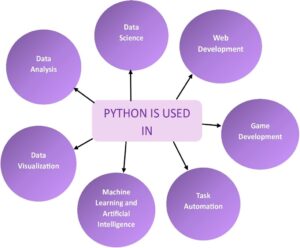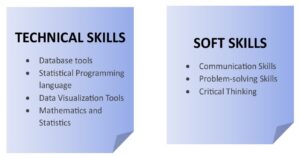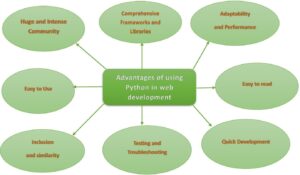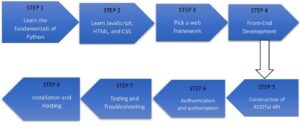Learn Python for Data Analysis
INTRODUCTION:
Python is an interpreted, object-oriented, high-level programming language. It is simple to learn and code in. It also has a large variety of libraries that are useful for analytics and complex calculations.
Python has become a well-known programming language in the field of data analysis. Because of its remarkable library selection, scalability, and flexibility, Python continues to be the preferred option.
The largest companies in the world are looking for data analysts, as data analysis has become one of the highest-demand careers globally.
Python provides modules and packages, improving program flexibility and code reuse. Python has applications across many sectors including:

DATA:
A collection of information obtained through measurements, study, analysis, or observation is called data. Data in digital format can be processed and transferred. Data is in many forms of information that are often formatted in a specific way. Data could be in any form, some types of data are geographical, cultural, scientific, financial, natural, transport, statistical, and meteorological data.
DATA ANALYSIS:
Data analysis is the process of obtaining insights from data to help make better business decisions.
Data analysis means investigating, cleansing, changing, and organizing data to gather information and help in decision-making. Being a data analyst, you will analyse huge data sets, find hidden patterns, and convert numbers into useful information.
It is the systematic application of statistical and/or logical tools to explain and show, condense conclude, and evaluate data.
It can take many forms, depending on the question you’re going to answer. We can say that there are four different types of data analysis:
- Descriptive Analysis
- Diagnostic Analysis
- Predictive Analysis
- Prescriptive Analysis
DATA ANALYST:
A person who collects and evaluates data to address a particular issue is known as a data analyst. In addition to spending a lot of time with data, the profession also requires communicating findings.
A data analyst examines data to discover critical insights about a company’s consumers and how the data may be used to address problems. They also share this information with company leaders and other stakeholders.
Here we can summarize the work of a data analyst in a simple way using a diagram:

A data analyst is someone who has the skills and knowledge to transform raw data into information and insights that can be used to make business choices.
There are many types of data analysts in this tech world. We want to list a few of them below:
- Business Analyst,
- Business Intelligence Analyst,
- Operations Research Analyst,
- Medical and Health Care Analyst,
- Market Research Analyst
- Quantitative Analyst,
- IT System Analyst,
- Financial Analyst, …. many more.
STEPS TO BECOME A DATA ANALYST:
If you want to become a data analyst, you must understand the two most significant skills: technical skills and soft skills. Let’s briefly explore the technical skills required to become a data analyst.

Technical Skills:
If you want to learn more about the data analyst’s technical skills, continue reading a few sentences. You have focused on the crucial four abilities needed for a data analyst.
- Database Tools:
SQL is commonly used for data analysis in large businesses and is considered one of the most crucial tools for analysts. SQL is also used by software developers for software development.
It is a common choice among data analysts since the code is easy to read and understand. It can also be used to modify and update data.
On the other hand, we have to learn Microsoft Excel for data analysis. The most important application for a data analyst to learn is Excel, which is the industry standard for data analysis.
With built-in pivot tables, they are without a doubt the most popular analytic tool available. This all-in-one data management tool makes it simple to import, analyze, clean, evaluate, and display your data.
- Statistical Programming Language:
Learning a statistical programming language, such as Python or R, will allow you to modify enormous amounts of data and solve complex equations.
We recommend you choose the programming language which is Python because Python is versatile and it is easy to learn and code.
When it comes to data analysis, Python is an accepted standard in fields like math, business, science, and engineering.
Popularity among data analysts is due to its flexibility, broad libraries, and simple syntax. Python’s ability to rapidly generate and manage data structures is one of its most popular uses.
Its dynamic typing and dynamic binding, along with its high-level built-in data structures, make it an excellent choice for data analysis.
- Data Visualization Tools:
The process of graphical data representation in the form of heat maps, charts, infographics, sparklines, geographic maps, or statistical graphs is known as data visualization.
You may easily communicate your findings to others by creating interactive charts, graphs, and dashboards with the use of data visualization tools such as PowerBI and Tableau.
PowerBI is an excellent choice for data visualization because it is simple to use and connects easily with other Microsoft products.
This makes it an excellent tool for companies that use Microsoft Office. Tableau is another popular alternative, with a large user base and a diverse set of capabilities.
By learning a data visualization tool, you will be able to produce interactive and fascinating visuals that will assist you in better understanding your data and communicating your results to others, making you an important asset to any data-driven company.
- Mathematics and Statistics:
Understanding the fundamentals behind what data tools do can greatly benefit your business. An in-depth knowledge of statistics and math can help you choose which methods are most suited to solving a certain problem, detect mistakes in your data, and better understand the results.
Understanding statistics is being able to sort through large amounts of data to extract high-level insights. Probability distributions, statistical characteristics, and Bayesian statistics are among the most common statistical topics to understand.
CONCLUSION:
In short, data analysis is a great career path with high demand and exciting chances. Data analysts play a crucial role in collecting, analyzing, and communicating insights that drive informed business decisions. Whether you’re just starting or wishing to improve your career, mastering abilities in mathematics, statistics, and data technologies is important. As we complete this comprehensive guide, it is clear that the demand for professional data analysts continues to increase, creating a landscape full of opportunities for those prepared with the necessary expertise.
Python in Web Development
INTRODUCTION:
Python web development is a popular and adaptable option for creating dynamic websites and web apps. A wide range of frameworks, modules, and tools are available for Python, which makes development easier and enables programmers to design scalable and effective web solutions.
It comprises designing, developing, and maintaining websites with a range of functions and uses by utilizing a variety of technologies, programming languages, and tools.
At its foundation, web development includes two essential aspects:
1. Front-end development
2. Back-end development

Front-end Development:
The visual and interactive components of a website that visitors interact with directly are the focus of front-end development. Using tools like HTML (Hypertext Markup Language), CSS (Cascading Style Sheets), and JavaScript, entails developing the layout, designing the user interface (UI), and implementing the visual components.
Back-end Development:
On the other hand, back-end development works with a website’s server-side functionality. It entails developing the architecture and logic needed to process data, manage database interactions, and maintain the operation of the website. Programming languages like Python, Ruby, Java, or PHP are used by back-end developers to create the server-side parts of websites.
WEB DEVELOPMENT USING PYTHON:
The process of developing websites and web applications with the Python programming language is known as Python web development. Python is a widely used and adaptable programming language that is well-known for its ease of use, readability, and extensive library and framework ecosystem.
Python is used by developers to construct server-side logic for web applications. This involves processing HTTP requests and responses, data storage and retrieval, business logic implementation, and dynamic content rendering.
SEVERAL ADVANTAGES TO USE PYTHON IN WEB DEVELOPMENT:

- Huge and Intense Community:
The Python community is large and vibrant, with many developers contributing to its development and providing assistance. Many tools, frameworks, and resources designed expressly for web development are available from the community. Python is a strong option for web development because of its wealth of community-driven tools and resources, which provide answers to a variety of needs.
- Comprehensive Frameworks and Libraries:
Python has a robust ecosystem of frameworks and tools that make web development chores easier. One of the most well-liked web frameworks for Python, Django, offers a sophisticated and comprehensive toolkit for creating intricate web applications. It is designed using the Model-View-Controller (MVC) architectural paradigm and comes pre-configured with features like URL routing, database ORM (Object-Relational Mapping), and authentication. Another lightweight and adaptable micro-framework that gives developers more control over the components and structure of an application is Flask. These frameworks, as well as others like Pyramid and Bottle, give web development a strong base and increase productivity.
- Adaptability and Performance:
Python is well-known for being performant and scalable, which makes it ideal for managing online applications with heavy traffic. Python frameworks like Django and asyncio can effectively manage concurrent requests and optimize server resources thanks to innovations like asynchronous programming. Furthermore, Python’s integration features make it simple to integrate with other languages, allowing programmers to use high-performance C or C++ libraries as necessary.
- Easy to read and use:
Python’s syntax is intended to be simple to understand and write, focusing on code readability and maintainability. Its simple syntax enables developers to express concepts in fewer lines of code, making development faster and more efficient. Python’s simplicity allows both new and experienced developers to work easily and collaboratively.
- Inclusion and Simplicity:
Python is adaptable for web development and interfaces with other technologies with ease. It supports a wide range of databases, including NoSQL databases like MongoDB and SQL-based databases like MySQL, PostgreSQL, and SQLite.
- Testing and Troubleshooting:
Python has strong testing frameworks that make developing and running tests for web applications easier, such unittest and pytest. Integrated development environments (IDEs) and pdb are two of the efficient debugging tools that enable developers to locate problems and solve them fast.
- Quick Development:
Python’s emphasis on productivity and simplicity makes it possible for developers to create web apps rapidly. Pre-built modules and libraries are readily available, allowing developers to take advantage of pre-existing solutions rather than having to start from scratch. Time-to-market is critical for startups and small-scale ventures, where this speedy development strategy is very helpful.
WEB DEVELOPMENT FRAMEWORKS IN PYTHON:
Python offers several web frameworks to suit different needs and preferences. The following are a few well-known Python web development frameworks:
- Django
- Flask
- Pyramid
- Bottle
- CherryPy
- Tornado
WEB DEVELOPMENT LIBRARIES IN PYTHON:
Python web development provides an abundance of tools and frameworks to improve productivity and improve the development process. The following libraries & tools are frequently used in Python web development:
- Jinja2
- Pydantic
- Redis-py
- PyJWT
- Flask-WTF
- Flask-SQLAlchemy
- Celery
- SQLAlchemy
- Pillow
- Beautiful Soup
- Requests
ROADMAP FOR PYTHON WEB DEVELOPMENT:
A road map for using Python to construct websites that highlights the main ideas and procedures involved:

- Learn the fundamentals of Python:
Learn the syntax, data types, control structures, and functions that are essential to Python programming. To begin started, you can consult books or internet guides.
- Learn JavaScript, HTML, and CSS:
Get a fundamental knowledge of web technologies, like JavaScript for client-side interactivity, CSS for styling, and HTML for markup. These are required to understand and design websites.
- Pick a web Framework:
Choose a Python web framework based on the needs of your project. A few well-liked choices are Pyramid, Flask, and Django.
- Front-end Development:
Develop your web development abilities by being familiar with well-known front-end frameworks and modules like Angular, Vue.js, and React.
- Construction of RESTful API:
Create APIs that provide data and functionality to other apps or front-end interfaces using the web framework of your choice.
- Authentication and Authorization:
Learn how to use the built-in capabilities or extensions of your web framework to develop secure user registration, login, and access control techniques.
- Testing and Troubleshooting:
Become an expert at testing your websites. Find out more about end-to-end, integration, and unit testing. To write and run tests, use tools such as pytest, Python’s Selenium, or the testing frameworks included with your preferred web framework.
- Installation and Hosting:
Find out how to put your web application on a cloud platform or web server. Gain an understanding of ideas like scalability, security considerations, deployment automation, and server setup. For hosting web applications, platforms like Heroku, AWS, or PythonAnywhere are frequently utilized.
CONCLUSION:
Python is a powerful language that is well-suited for web development, which involves developing websites and web apps. Because of its ease of use, readability, and robust environment, Python is a great option for web development projects. Python offers a strong basis for web development, making it possible for programmers to create feature-rich, scalable websites quickly.
Recent Posts
Categories
- All
- Angularjs training in Chennai
- ASP.NET Core
- dot net training
- dot net training in chennai
- dotnet full stack developer
- Free dotnet training
- information on dotnet
- Learn Java in chennai
- Learn Python at Karaikudi
- learn python online
- learn python online from chennai
- Linq Queries in .net
- mutual funds
- MVC Training Tutorials
- PHP Training in Chennai
- pmp training online
- power apps online training
- Python Training Online
- share market
- Sharepoint framework online training
- SharePoint Freelancers in Chennai
- software testing
- spfx online training
- Stock market
- Uncategorized
